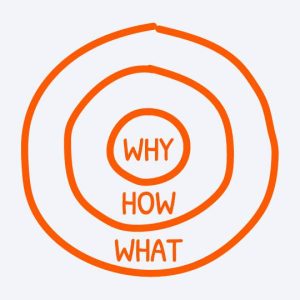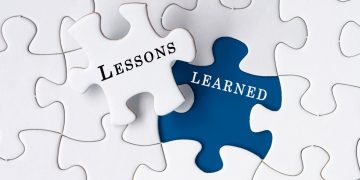Do you wish to be an effective leader and inspire others? Simon Sinek believes that the answer is to understand the three concentric circles of Why, How, and What.
Simon Sinek, a best-selling author, gained widespread recognition with his 2010 TED talk “How Great Leaders Inspire Action,” based on his first book, Start with Why. This talk became one of the most-viewed TED talks, solidifying his influence in leadership thinking. Sinek’s follow-up book, Leaders Eat Last, also became a bestseller, appearing on the Wall Street Journal and The New York Times lists.
In his “Start with Why” book, Sinek shows that the leaders who’ve had the greatest influence in the world all think, act, and communicate the same way, and it’s the opposite of what everyone else does. According to Sinek, most organizations and people communicate from the outside in, starting with “what” (the clearest), moving to “how”, and often neglecting “why” (the fuzziest).
Sinek also introduces the idea of The Golden Circle, which provides a framework upon which organizations can be built, movements can be led, and people can be inspired. The three concentric circles are:
- What: Every organization knows what they do. This includes the products they sell or the services they provide.
- How: Some organizations know how they do what they do. This could be their unique selling proposition, differentiation strategy, or their proprietary process.
- Why: Very few organizations understand why they do what they do. This refers to their purpose, cause, or belief. It answers the fundamental question, “Why does this organization exist?” or “Why do you get out of bed in the morning?”

However, the most inspiring leaders and organizations, like Apple, Martin Luther King Jr., and the Wright brothers, communicate from the inside out, starting with Why, then moving to How, and finally to What. This approach resonates deeply with people because it speaks to their emotions and beliefs.
The key idea is that people don’t buy what you do; they buy why you do it. This concept explains why some companies, movements, or leaders inspire loyalty and achieve remarkable success while others do not.
In his TED talk, Sinek highlights how the limbic brain, responsible for emotions, trust, and loyalty but not language processing, impacts our decision-making process. This explains why people say, “It just doesn’t feel right” when facts don’t align with their emotions or gut instinct. These decisions are based on deeper feelings rather than rational analysis, which is why people often find it challenging to articulate their choices beyond simply stating, “It doesn’t feel right.” Thus, Sinek underscores the importance of understanding and communicating why you do what you do.
He argues that people are drawn to those who share similar beliefs, rather than just products or services. For example, he contrasts the Wright brothers with Samuel Pierpont Langley. Despite their lack of resources, education, and media attention, the Wright brothers were able to create controlled, powered flight because of their passion for changing the world. Their team adhered to this viewpoint and put in a lot of effort for a greater cause. Langley, on the other hand, had all the resources and public support, but his motivations were fame and money. When the Wright brothers succeeded, Langley quit because he didn’t achieve his goal of being first or famous.
Sinek also mentions the Law of Diffusion of Innovation, a theory that seeks to explain how, why, and at what rate new ideas and technology spread. American sociologist and communication theorist Everett Rogers first published his book Diffusion of Innovations in 1962, which popularized the theory.
 According to this theory, the first 2.5% of people are innovators, followed by 13.5% early adopters, paving the way for mass-market success. To achieve mass-market success, an idea must penetrate 15-18% of the market, reaching a tipping point for widespread adoption.
According to this theory, the first 2.5% of people are innovators, followed by 13.5% early adopters, paving the way for mass-market success. To achieve mass-market success, an idea must penetrate 15-18% of the market, reaching a tipping point for widespread adoption.
Sinek stresses that businesses shouldn’t just chase after the general market but focus on early adopters, who resonate with the company’s “why.” These early adopters are essential to achieving mass acceptance, as they help spread the idea to the early and late majority.
Simon Sinek also cites another concept by Jeffrey Moore, an American organizational theorist, management consultant, and author, known as “Crossing the Chasm.” According to this theory, the early majority are hesitant to try new things until someone else has done it first.
Innovators and early adopters, on the other hand, are more comfortable making intuitive, gut decisions based on their beliefs about the world rather than solely on the product’s availability.
These are the people who stood in line for six hours to buy the first iPhone, driven by their belief in the product’s potential rather than simply its features.
… he explained.
How can someone find their “why”?
According to Simon Sinek, finding your “why” is about understanding your origin story—the experiences and influences that shaped you by your mid- to late teens. Your “why” is tied to your upbringing and doesn’t change throughout your life, though how aligned you are with it can vary.
To discover your “why,” Sinek suggests a personal exercise with a close friend. Ask them, “Why are we friends?” and follow up by asking, “What specifically is it about me that makes you know you’d be there for me no matter what?” After several rounds of thought, they’ll eventually describe something about themselves and how you inspire them. This emotional response, often marked by goosebumps or an emotional reaction, indicates when you’ve hit upon your true “why.”
In teams or organizations, the “why” is rooted in the founding story, reflecting the original purpose that drove the creation of the group or company. Sharing stories that capture why people love coming to work every day helps articulate this shared “why” in a workplace setting.
Great companies don’t hire skilled people and motivate them; they hire already motivated people and inspire them. People are either motivated or they are not. Unless you give motivated people something to believe in, something bigger than their job to work toward, they will motivate themselves to find a new job, and you’ll be stuck with whoever’s left.
… says Sinek in his book.


































































